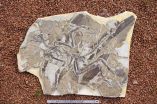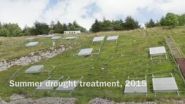(Press-News.org) PROVIDENCE, R.I. [Brown University] -- A study provides multiple lines of new evidence that pigments and the microbodies that produce them can remain evident in a dinosaur fossil. In the journal Scientific Reports, an international team of paleontologists correlates the distinct chemical signature of animal pigment with physical evidence of melanosome organelles in the fossilized feathers of Anchiornis huxleyi, a bird-like dinosaur that died about 150 million years ago in China.
The idea that melanosomes, which produce melanin pigment, are preserved in fossils has been hotly debated among scientists during the last several years. Microscopic traces that to some scientists seem to resemble melanosomes, appear to skeptics to instead be similar-looking bacteria. The new study resolves the debate, said co-author Ryan Carney, a graduate student at Brown University, by adding a powerful second line of evidence: chemistry.
"We have integrated structural and molecular evidence that demonstrates that melanosomes do persist in the fossil record," said Carney, who helped design and write the study. "This evidence of animal-specific melanin in fossil feathers is the final nail in the coffin that shows that these microbodies are indeed melanosomes and not microbes."
The finding has important implications for the interpretation of both past and future studies on fossil color, Carney said, and substantiates prior proposals that Anchiornis had some dark black feathers.
Signatures of animal pigment
In the new study, led by Johan Lindgren of Lund University in Sweden, the team used electron microscopes to observe what appear to be rod-like melanosome structures and imprints within the barbules of feathers all over the body.
That morphological evidence alone, however, would not advance the debate, so in addition the team performed two different kinds of chemical analyses to see if they could detect animal eumelanin pigment. They used both time-of-flight secondary ion mass spectrometry and infrared reflectance spectroscopy to discern the molecular signature of melanin in the samples. They compared those observed signatures with the signatures of modern-day animal eumelanin. The melanins were virtually identical, except for minor contributions from sulfur in the fossil, Carney said.
The researchers also analyzed the observed spectral signatures to compare them with melanins produced by various microbes, just to make sure that the pigments were not from any other source. The closest spectral agreement remained with an animal source, however.
"This is animal melanin, not microbial melanin, and it is associated with these melanosome-like structures in the fossil feathers," Carney said.
Furthermore, no other types of molecules from potential microbes were detected.
INFORMATION:
In addition to Lindgren and Carney, the paper's other authors are Peter Sjövall, Aude Cincotta, Per Uvdal, Steven Hutcheson, Ola Gustafsson, Ulysse Lefèvre, François Escuillié, Jimmy Heimdal, Anders Engdahl, Johan Gren, Benjamin Kear, Kazumasa Wakamatsu, Johan Yans and Pascal Godefroit.
The Swedish Research Council, the Crafoord Foundation and the National Geographic Society funded the research.
Physicists have found a radical new way confine electromagnetic energy without it leaking away, akin to throwing a pebble into a pond with no splash.
The theory could have broad ranging applications from explaining dark matter to combating energy losses in future technologies.
However, it appears to contradict a fundamental tenet of electrodynamics, that accelerated charges create electromagnetic radiation, said lead researcher Dr Andrey Miroshnichenko from The Australian National University (ANU).
"This problem has puzzled many people. It took us a year to get this ...
COLUMBUS, Ohio - Many clinical trials use genome sequencing to learn which gene mutations are present in a patient's tumor cells. The question is important because targeting the right mutations with the right drugs can stop cancer in its tracks. But it can be difficult to determine whether there is evidence in the medical literature that particular mutations might drive cancer growth and could be targeted by therapy, and which mutations are of no consequence.
To help molecular pathologists, laboratory directors, bioinformaticians and oncologists identify key mutations ...
A study by the University of Liverpool has found that the genetic diversity of wild plant species could be altered rapidly by anthropogenic climate change.
Scientists studied the genetic responses of different wild plant species, located in a natural grassland ecosystem near Buxton, to a variety of simulated climate change treatments--including drought, watering, and warming--over a 15-year period.
Analysis of DNA markers in the plants revealed that the climate change treatments had altered the genetic composition of the plant populations. The results also indicated a ...
Twitter offers a public platform for people to post and share all sorts of content, from the serious to the ridiculous. While people tend to share political information with those who have similar ideological preferences, new research from NYU's Social Media and Political Participation Lab demonstrates that Twitter is more than just an "echo chamber."
The research is published in Psychological Science, a journal of the Association for Psychological Science.
"Platforms like Twitter or Facebook are creating unprecedented opportunities for citizens to communicate with ...
Philadelphia, PA, August 27, 2015 - About 3% of colorectal cancers are due to Lynch syndrome, an inherited cancer susceptibility syndrome that predisposes individuals to various cancers. Close blood relatives of patients with Lynch syndrome have a 50% chance of inheritance. The role that PMS2 genetic mutations play in Lynch syndrome has been underestimated in part due to technological limitations. A new study in the Journal of Molecular Diagnostics describes a multi-method strategy to overcome existing technological limitations by more accurately identifying PMS2 gene mutations, ...
Needham, MA.-JBJS Case Connector, an online case report journal published by The Journal of Bone and Joint Surgery, has issued a "Watch" regarding relatively rare but potentially catastrophic complications from failure of modular head-neck prostheses commonly used in hip-replacement surgery.
The arthroplasty community currently feels that the advantages gained from modularity in hip implants outweigh the risks, but this Watch raises that risk-benefit question again. The decision to issue the Watch was prompted by a case report by Swann et al. in the August 26, 2015 JBJS ...
Analysis of blood samples from more than 5,000 people suggests that a more sensitive version of a blood test long used to verify heart muscle damage from heart attacks could also identify people on their way to developing hypertension well before the so-called silent killer shows up on a blood pressure machine.
Results of the federally funded study, led by Johns Hopkins investigators, found that people with subtle elevations in cardiac troponin T -- at levels well below the ranges detectable on the standard version of this "heart attack" test -- were more likely to be ...
Dogs get cancer, too. And they have even fewer treatment options than their human owners do. But an article in Chemical & Engineering News (C&EN), the weekly newsmagazine of the American Chemical Society, offers a glimmer of hope. It explores how clinical trials on man's best friend could be a win-win for both dogs and people.
Judith Lavelle, an intern at C&EN, notes that only a small percentage of potential human cancer drugs get approved by the U.S. Food and Drug Administration. Many of them fail when tested in people in clinical trials. A major reason for this late ...
GeoSpace
Terraced craters: Windows into Mars' icy past
Just beneath Mars' dirt surface, or regolith, researchers found an enormous slab of water ice, measuring 40 meters (130 feet) thick, and covering an area equivalent to that of California and Texas combined, according to a new study published today in Geophysical Research Letters.
Eos.org
What lies deep in the mantle below?
For decades, scientists have probed Earth's remote mantle by analyzing how seismic waves of distant earthquakes pass through it. But we are still challenged by the technique's limitations.
New ...
WORCESTER, MA -- Researchers have determined how the most common gene mutation in amyotrophic lateral sclerosis (ALS) and frontotemporal dementia (FTD) disrupts normal cell function, providing insight likely to advance efforts to develop targeted therapies for these brain diseases. Scientists from the University of Massachusetts Medical School (UMMS) and St. Jude Children's Research Hospital led the research, which appeared in the science journal Nature.
Investigators reported evidence that mutation of C9ORF72 interferes with the movement of RNAs and proteins into and ...



